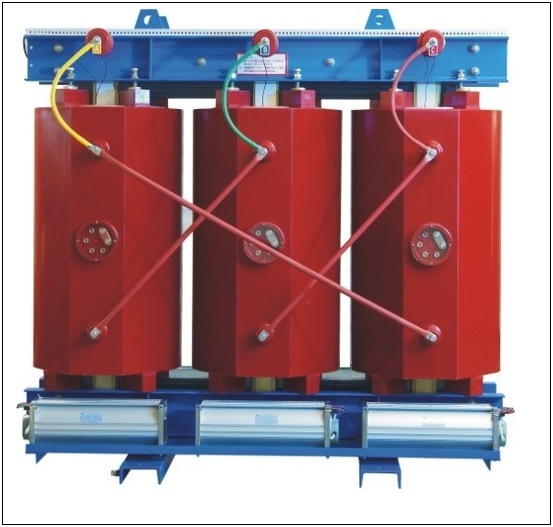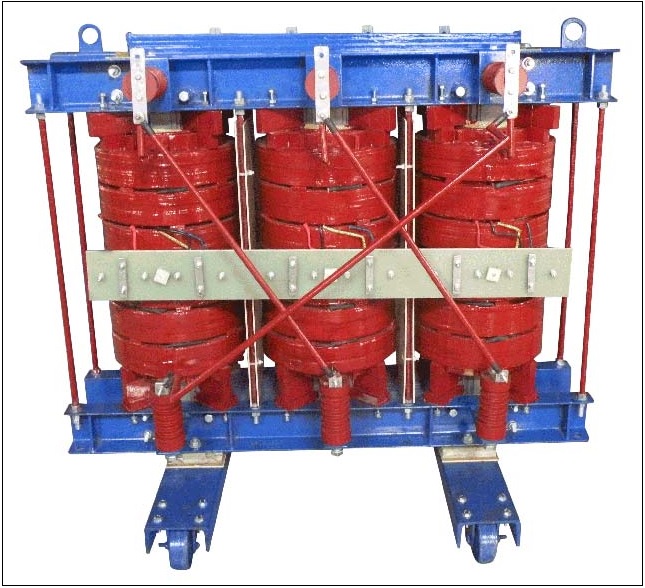CRT/VPI
Dry type transformer never uses any insulating liquid where its winding with core be immerged. Rather windings with core are kept within a sealed tank that is pressurized with air.
Type of Dry Type Transformer
The dry type transformer is of two types. They are
- Cast Resin Dry Type Transformer ( CRT)
- Vacuum pressure Impregnated Transformer ( VPI)
1.Cast Resin Dry Type Transformer ( CRT)
Cast resin dry type transformer (CRT) is used in the high moisture prone areas. It is because of its primary and secondary windings are encapsulated with epoxy resin. This encapsulation helps to prevent moisture to penetrate to affect the winding material. Complete protection is achieved by this cast resin encapsulation so that the transformer can work without disruption in highly moisture prone area. Thus this transformer is non hygroscopic. This type of transformer is available in ratings of 25 KVA to 12,500 KVA. with insulation class of F (90oC Temp. Rise).

This type of transformer has some featured advantages. They are-
- Better over load capacity.
- Low partial discharge along with low loss. Hence efficiency is very good.
- As it is with non inflammable winding insulation, it offers zero risk to fire hazard. So it is suitable for indoor installation.
- Can be fitted outdoor in IP 45 enclosure.
- And off course non hygroscopic.
2.Vacuum Pressure Impregnated Transformer (VPI)
This type of transformer is made with minimum flammable material as insulation of windings. The windings of this transformer are made in foil or strip in a continuous layer. But for higher voltages, the winding is made of disks that are connected in series or parallel as per power rating with respect to voltage level. The insulation of the winding is void free impregnation that is made with class H polyester resin. The primary and secondary winding with core are laced safely within a vacuum protective box. Moisture Ingress Protection is high and it never gets affected by moisture.

This type of transformer is available from 5KVA to 30MVA with insulation grade F(155oC) and H(180oC). It’s with Protection up to IP56. This type of transformer has several advantages. They are-
- High mechanical strength.
- Void free insulation.
- No temperature fluctuation.
- Easy maintenance.
- Less prone to fire hazard.
Advantages of Dry Type Transformer:-
- Safety for people and property.
- Maintenance and pollution-free solution.
- Easy installation.
- Side clearance is less.
- Environmentally friendly.
- Excellent capacity to support overloads.
- Reduced cost on civil installation works and fire protection systems.
- Excellent performance in case of seismic events.
- No fire hazard.
- Excellent resistance to short circuit currents.
- Long lasting due to low thermal and dielectric heating.
- Suited for damp and contaminated areas.
Disadvantages of Dry Type Transformer:-
- Dry type transformer is long lasting and with less chance of winding failure. But once it fails whole set up is to changed, i.e. complete change of high voltage and low voltage winding with limb.
- For same power and voltage rating, dry type transformer is costlier than oil cooled transformer.
Application of Dry Type Transformer:-
- Chemical, oil and gas industry
- Environmentally sensitive areas (e.g. water protection areas)
- Fire-risk areas (e.g. forests)
- Inner-city substations
- Indoor and underground substations
- Renewable generation
